Radio Shack PRO-2016 User Guide
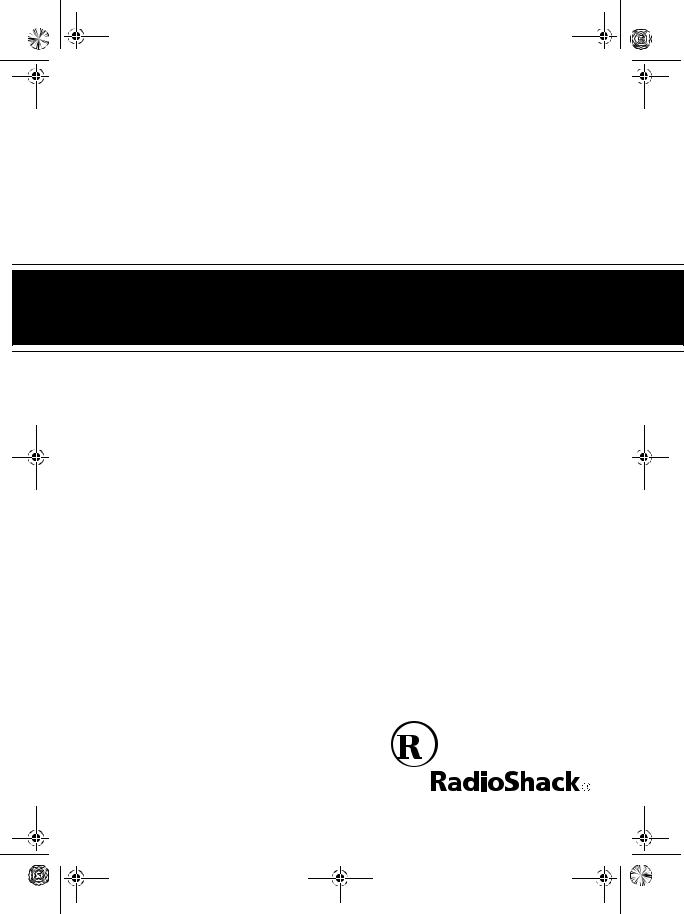
20-422.fm Page 1 Friday, January 7, 2000 12:54 PM
Cat. No. 20-422
OWNER’S MANUAL
Please read before using this equipment.
200CH VHF/Air/UHF Home Scanner
with Scanner Control Protocol and WX Alert
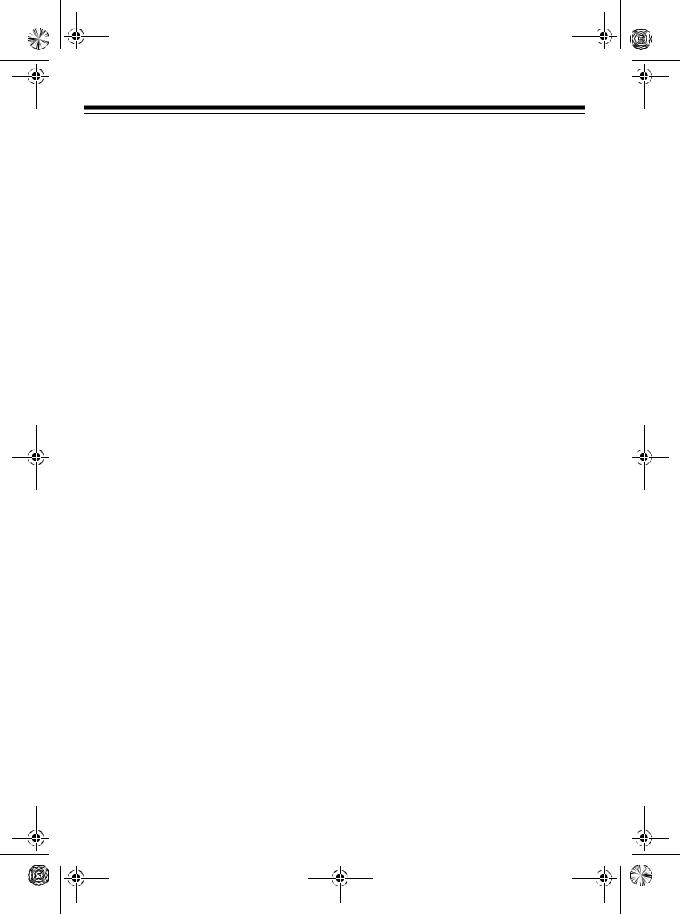
20-422.fm Page 2 Friday, January 7, 2000 12:54 PM
FEATURES
Your RadioShack 200Ch VHF/Air/UHF Home Scanner lets you in on all the action! This scanner gives you direct access to over 23,000 frequencies, including those used by police and fire departments, ambulance and transportation services, government agencies, and amateur radio services. You can select up to 200 channels to scan and you can change selections at any time.
The scanner’s frequency bands let you search specific, preset ranges of frequencies quickly and easily.
Your scanner has all these special features:
Weather Alert — warns you of serious weather conditions by sounding an alarm if the weather service transmits a weather alert tone.
Weather Band Key — scans seven preprogrammed weather channels to keep you informed about current weather conditions.
Scanner Control Protocol — lets you download channel information (frequency, lockout, priority, delay) from your PC to the scanner.
Ten 20-Channel Storage Banks — let you store 20 channels in each of ten banks to group channels so calls are easier to identify.
Ten Monitor Memories — let you temporarily save ten frequencies located during a frequency search, so you can decide if you want to store them permanently.
Priority Channels — let you set the scanner to check up to ten channels every 2 seconds so you do not miss important calls.
Band Search — lets you quickly and easily search preset frequency ranges, so you can find new and unlisted broadcasts.
Direct Search — lets you search for a transmission starting from a specified frequency.
Search Skip — lets you select up to 20 frequencies for the scanner to skip during a search, so you can search more efficiently.
Two-Second Channel Scan/Search Delay — lets you set the scanner so it delays scanning or searching for 2 seconds before moving to another channel/ frequency, so you can hear more replies.
Lock-Out — keeps channels you select from being scanned, so you can skip over busy channels such as those with a continuous transmission.
© 1999 Tandy Corporation.
All Rights Reserved.
RadioShack is a registered trademark used by Tandy Corporation.
2
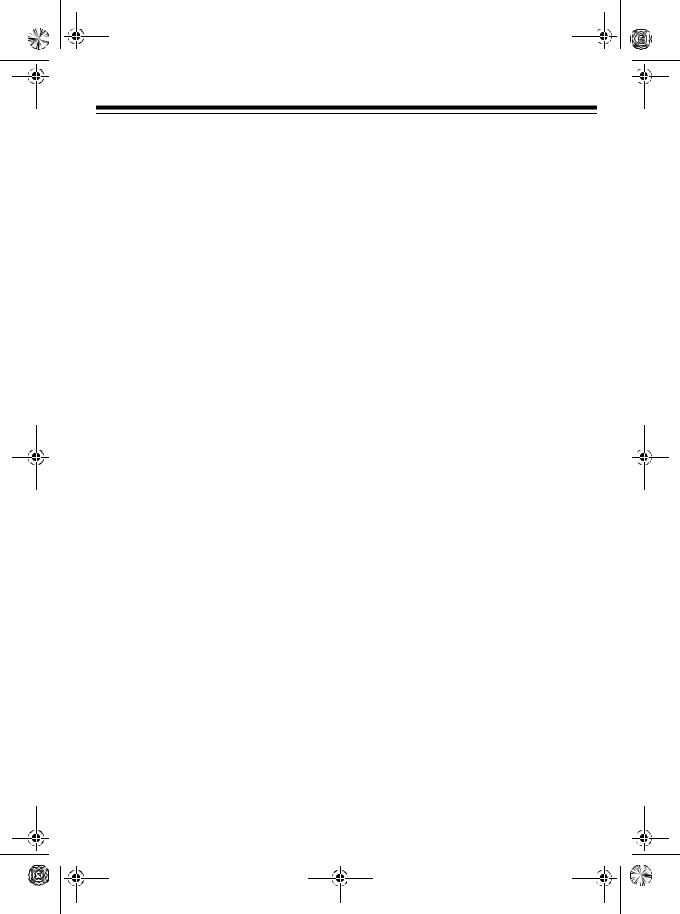
20-422.fm Page 3 Friday, January 7, 2000 12:54 PM
Key Confirmation Tones — the scanner sounds a tone when you perform an operation correctly and sounds an error tone if you make an error.
Memory Backup — keeps channel frequencies stored in memory for an extended time even if your scanner loses power.
External Speaker Jack — lets you connect an external speaker, or an earphone or headphones for private listening.
External Antenna Terminal — lets you connect an external antenna (not supplied) for improved reception.
Your scanner can receive all of these frequencies:
•29–54 MHz (10-Meter Amateur Radio, VHF Lo, 6-Meter Amateur)
•108–136.975 MHz (Aircraft)
•137–174 MHz (Government, 2- Meter Amateur Radio, VHF Hi)
•406–512 MHz (UHF Lo, 70-Centi- meter Amateur Radio, Government, UHF “T” Band)
This table shows the preset frequency steps your scanner uses for each frequency range.
Frequency |
|
Range (MHz) |
Step (kHz) |
29–54 |
5 |
108–136.975 |
12.5 |
137–144 |
5 |
144–148 |
5 |
148–174 |
5 |
406–450 |
12.5 |
450–470 |
12.5 |
470–512 |
12.5 |
Note: The frequency steps are preset. You cannot change them.
Your scanner can also receive these preprogrammed weather channel frequencies:
•162.400 MHz
•162.425 MHz
•162.450 MHz
•162.475 MHz
•162.500 MHz
•162.525 MHz
•162.550 MHz
3

20-422.fm Page 4 Friday, January 7, 2000 12:54 PM
FCC NOTICE
Your scanner might cause TV or radio interference even when it is operating properly. To determine whether your scanner is causing the interference, turn off your scanner. If the interference goes away, your scanner is causing it. Try to eliminate the interference by:
•moving your scanner away from the receiver
•connecting your scanner to an outlet that is on a different electrical circuit from the receiver
•contacting your local RadioShack store for help
If you cannot eliminate the interference, the FCC requires that you stop using your scanner.
This device complies with Part 15 of the FCC Rules. Operation is subject to the following conditions: (1) This device must not cause harmful interference and
(2) this device must accept any interference received, including interference that may cause undesired operation.
SCANNING LEGALLY
Your scanner covers frequencies used by many different groups including police and fire departments, ambulance services, government agencies, private companies, amateur radio services, military operations, pager services, and wireline (telephone and telegraph) service providers. It is legal to listen to al-
4
most every transmission your scanner can receive. However, there are some transmissions you should never intentionally listen to. These include:
•telephone conversations (cellular, cordless, or other private means of telephone signal transmission)
•pager transmissions
•any scrambled or encrypted transmissions
According to the Electronic Communications Privacy Act (ECPA), you are subject to fines and possible imprisonment for intentionally listening to, using, or divulging the contents of such a transmission unless you have the consent of a party to the communication (unless such activity is otherwise illegal).
This scanner has been designed to prevent reception of illegal transmissions. This is done to comply with the legal requirement that scanners be manufactured so as to not be easily modifiable to pick up those transmissions. Do not open your scanner’s case to make any modifications that could allow it to pick up transmissions that it is not legal to listen to. Doing so could subject you to legal penalties.
We encourage responsible, legal scanner use.
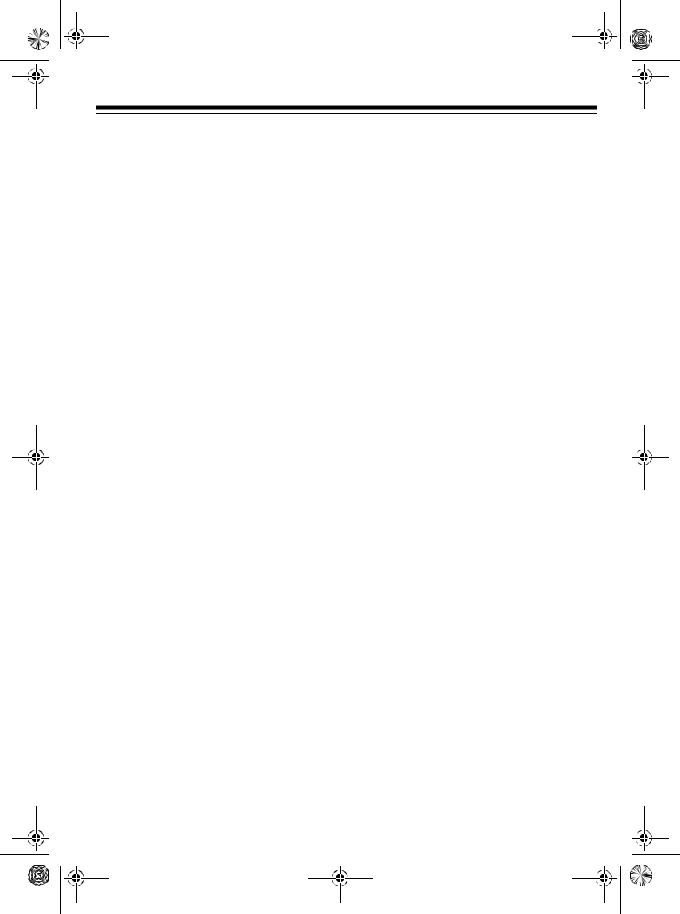
20-422.fm Page 5 Friday, January 7, 2000 12:54 PM
CONTENTS |
|
Preparation .............................................................................................................. |
6 |
Removing the Display Protector ......................................................................... |
6 |
Connecting an Antenna ...................................................................................... |
6 |
Connecting Power .............................................................................................. |
7 |
Connecting an External Speaker ........................................................................ |
8 |
Connecting an Earphone or Headphones .......................................................... |
8 |
Understanding Your Scanner ................................................................................ |
9 |
A Look at the Front Panel ................................................................................... |
9 |
A Look at the Display ....................................................................................... |
10 |
Understanding Banks and Bands ....................................................................... |
12 |
Channel-Storage Banks ................................................................................... |
12 |
Monitor Memories ............................................................................................. |
12 |
Frequency Bands ............................................................................................. |
12 |
Operation ............................................................................................................... |
14 |
Turning On the Scanner/Setting Volume and Squelch ..................................... |
14 |
Resetting the Scanner ...................................................................................... |
14 |
Manually Storing Frequencies into Channels ................................................... |
14 |
Searching For and Temporarily Storing Active Frequencies ............................ |
15 |
Listening to Monitor Memories ......................................................................... |
16 |
Moving a Frequency From a Monitor Memory to a Channel ............................ |
17 |
Deleting a Frequency From a Channel ............................................................ |
17 |
Scanning Channels .......................................................................................... |
17 |
Manually Selecting a Channel .......................................................................... |
18 |
Special Features ................................................................................................... |
19 |
Delay ................................................................................................................ |
19 |
Skipping Frequencies/Channels ....................................................................... |
19 |
Priority .............................................................................................................. |
20 |
Listening to the Weather Band ......................................................................... |
21 |
Turning the Key Tone On or Off ........................................................................ |
21 |
A General Guide to Scanning .............................................................................. |
22 |
Guide to Frequencies ....................................................................................... |
22 |
Guide to the Action Bands ................................................................................ |
23 |
Band Allocation ................................................................................................ |
24 |
Frequency Conversion ..................................................................................... |
27 |
Troubleshooting .................................................................................................... |
28 |
Care and Maintenance .......................................................................................... |
29 |
Specifications ....................................................................................................... |
30 |
|
5 |

20-422.fm Page 6 Friday, January 7, 2000 12:54 PM
PREPARATION
This scanner is designed for use in the home as a base station. You can place it on any flat surface such as a desk, shelf, or table.
REMOVING THE DISPLAY PROTECTOR
Your scanner’s display is protected during shipment by a piece of film. Peel off this film before you use the scanner.
CONNECTING AN
ANTENNA
Connecting the Supplied
Antenna
You must install an antenna before you can operate the scanner.
The supplied telescoping antenna helps your scanner receive strong local signals. To install the antenna, thread it clockwise into the hole on the scanner’s top.
The scanner’s sensitivity depends on the antenna’s length and various environmental conditions. For the best re-
ception of the transmissions you want to hear, adjust the antenna’s length.
Frequency |
Antenna Length |
(MHz) |
|
29–54 |
Extend fully |
108–174 |
Collapse one segment |
406–512 |
Collapse both segments |
Connecting an Outdoor
Antenna
Instead of the supplied antenna, you can connect an outdoor base-station antenna (not supplied) to your scanner. Your local RadioShack store sells a variety of antennas. Choose the one that best meets your needs.
When deciding on a base-station antenna and its location, consider these points:
•The antenna should be as high as possible on the house.
•The antenna and its cable should be as far as possible from sources of electrical noise such as appliances or other radios.
•The antenna should be vertical for the best performance.
To connect a base-station antenna, first remove the supplied antenna from the scanner. Always use 50-ohm coaxial cable, such as RG-58 or RG-8, to connect the base-station antenna. For lengths over 50 feet, use RG-8 low-loss dielectric coaxial cable. If the antenna cable’s connector does not fit in the ANT jack, you might also need an antenna plug
6
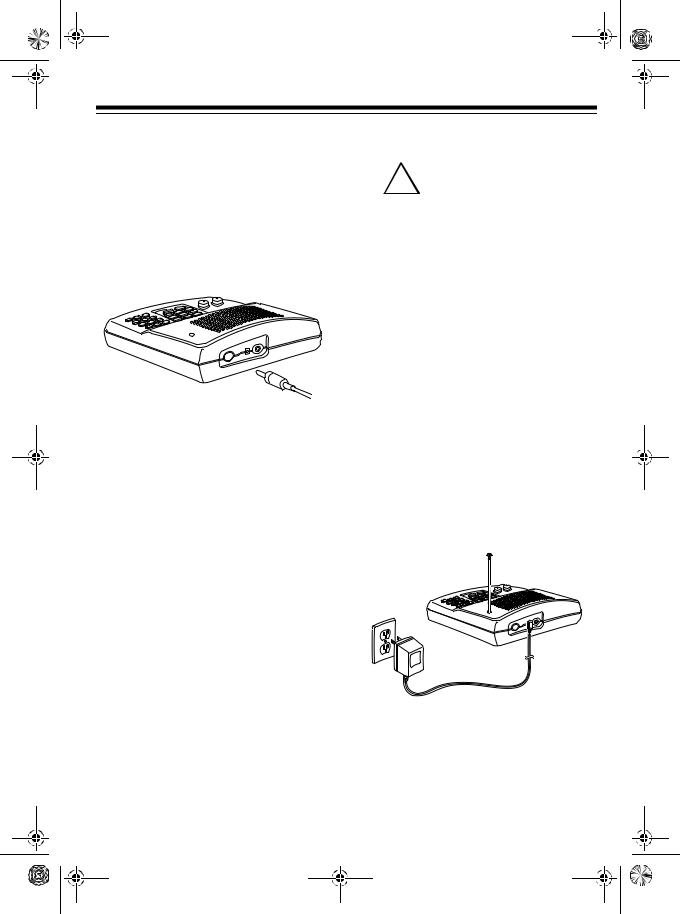
20-422.fm Page 7 Friday, January 7, 2000 12:54 PM
adapter. Your local RadioShack store carries a wide variety of coaxial antenna cable and connectors.
Once you choose an antenna, follow the mounting instructions supplied with the antenna. Then route the antenna’s cable to the scanner and connect the cable to the ANT jack on the back of the scanner.
Cautions:
•Do not run the cable over sharp edges or moving parts that might damage it.
•Do not run the cable next to power cables or other antenna cables.
•Follow all cautions and warnings included with your antenna.
Cautions:
You must use a Class 2
!power source that supplies 10V AC and delivers 300
mA. Its plug must fit the scanner’s AC 10V jack. The supplied adapter meets these specifications. Using an adapter that does not meet these specifications could damage the scanner or the adapter.
•A replacement adapter is available by special order through your local RadioShack store.
•Always connect the AC adapter to the scanner before you connect it to AC power. When you finish, disconnect the adapter from AC power before you disconnect it from the scanner.
Insert the AC adapter’s barrel plug into the AC 10V jack on the back of the scanner, then plug the AC adapter into a standard AC outlet.
CONNECTING POWER
Use the supplied 10V, 300-mA AC adapter to power the scanner.
Warning: Do not use the AC adapter’s polarized plug with an extension cord receptacle unless the blades can be fully inserted to prevent blade exposure.
7
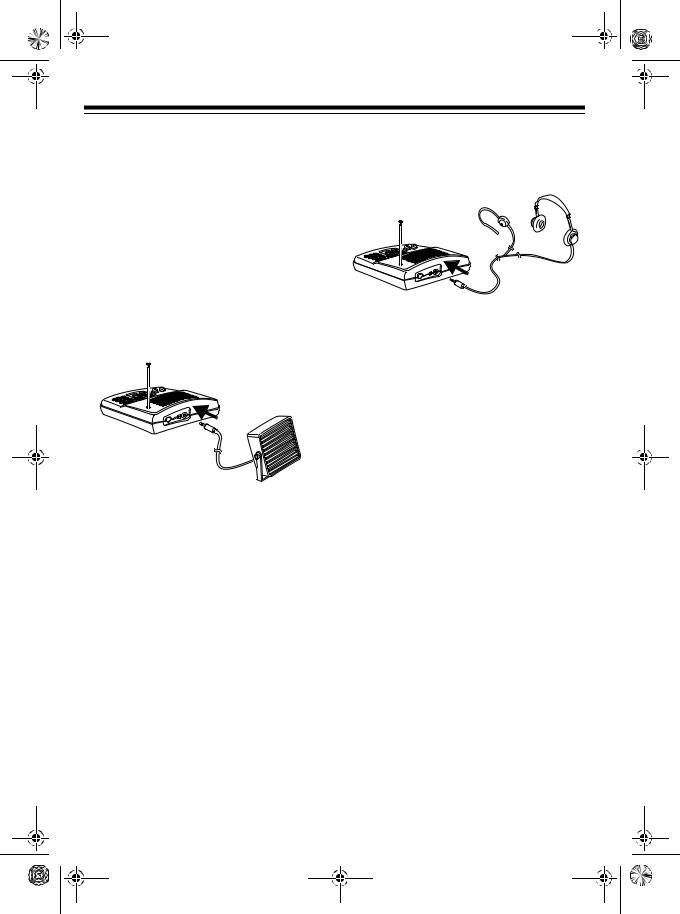
20-422.fm Page 8 Friday, January 7, 2000 12:54 PM
CONNECTING AN EXTERNAL SPEAKER
You can connect an optional external speaker with a 1/8-inch (3.5-mm) plug to the scanner. Use an 8-ohm external speaker that can handle at least 2.5 watts of power. Your local RadioShack store sells scanner accessories, including external speakers.
Insert the speaker’s plug into the EXT. SP. jack on the back of the scanner.
Insert the earphone’s or headphones’ plug into the EXT. SP. jack on the back of the scanner.
Note: Plugging in an earphone or headphones disconnects the scanner’s internal speaker.
Note: Plugging in an external speaker disconnects the scanner’s internal speaker.
CONNECTING AN
EARPHONE OR
HEADPHONES
You can connect an optional earphone or pair of monaural headphones with a 1/8- inch (3.5-mm) plug to the scanner. Your local RadioShack store sells a complete line of earphones and headphones.
8
Listening Safely
To protect your hearing, follow these guidelines when you use an earphone/ headphones.
•Set the volume to the lowest setting before you begin listening. After you begin listening, adjust the volume to a comfortable level.
•Do not listen at extremely high volume levels. Extended high-volume listening can lead to permanent hearing loss.
•Once you set the volume, do not increase it. Over time, your ears adapt to the volume level, so a volume level that does not cause discomfort might still damage your hearing.
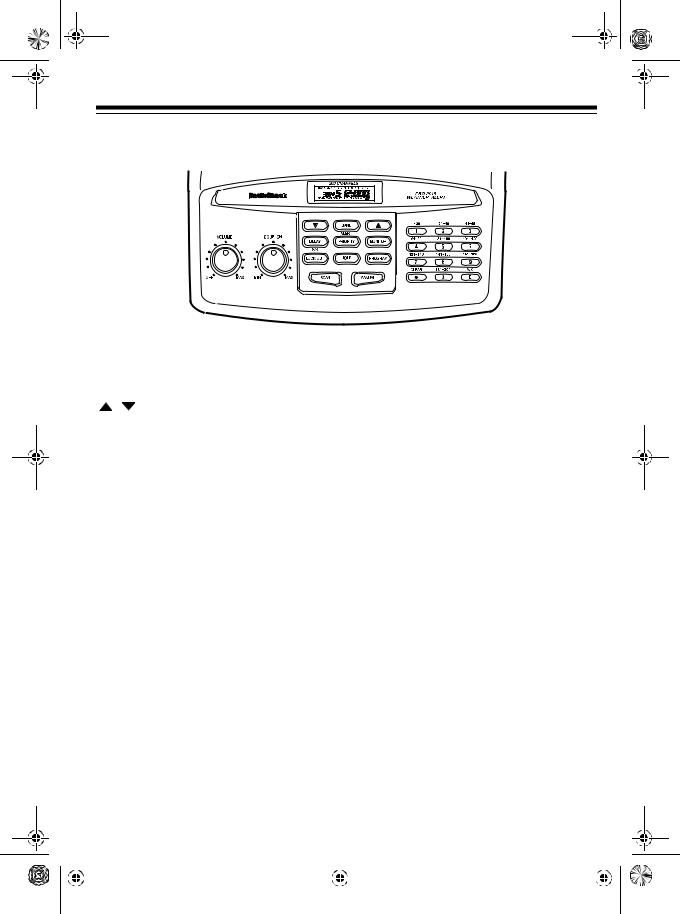
20-422.fm Page 9 Friday, January 7, 2000 12:54 PM
UNDERSTANDING YOUR SCANNER
A LOOK AT THE FRONT PANEL
|
|
|
|
|
|
|
|
|
|
|
|
|
VOLUME |
Turns the scanner on or off and adjusts the volume. |
|||||||||
|
SQUELCH |
Adjusts the scanner’s squelch. |
|||||||||
/ |
Sets the search direction. |
||||||||||
|
BAND |
Searches a band you select. |
|||||||||
|
DELAY |
Programs a 2-second delay for the selected channel; sets a |
|||||||||
|
|
|
delay for all active frequencies during a search. |
||||||||
|
ALERT/PRIORITY |
Sets the scanner to the weather alert mode; turns priority on |
|||||||||
|
|
|
or off for a particular channel. |
||||||||
|
MONITOR |
Stores frequencies into, and accesses, the ten monitor |
|||||||||
|
|
|
memories. |
||||||||
|
S/S-LOCKOUT |
Skips a specified frequency during a band or direct search |
|||||||||
|
(search/skip/lockout) |
or locks out selected channels during scanning. |
|||||||||
|
HOLD |
Pauses the scanner during a search. |
|||||||||
|
PROGRAM |
Programs frequencies into channels. |
|||||||||
|
SCAN |
Scans through the channels. |
|||||||||
|
MANUAL |
Stops scanning to let you listen to a monitor memory or di- |
|||||||||
|
|
|
rectly enter a channel number. |
||||||||
|
|
|
9 |
|
|||||||
|
|
|
|
|
|
|
|
|
|
|
|
|
|
|
|
|
|
|
|
|
|
|
|
|
|
|
|
|
|
|
|
|
|
|
|
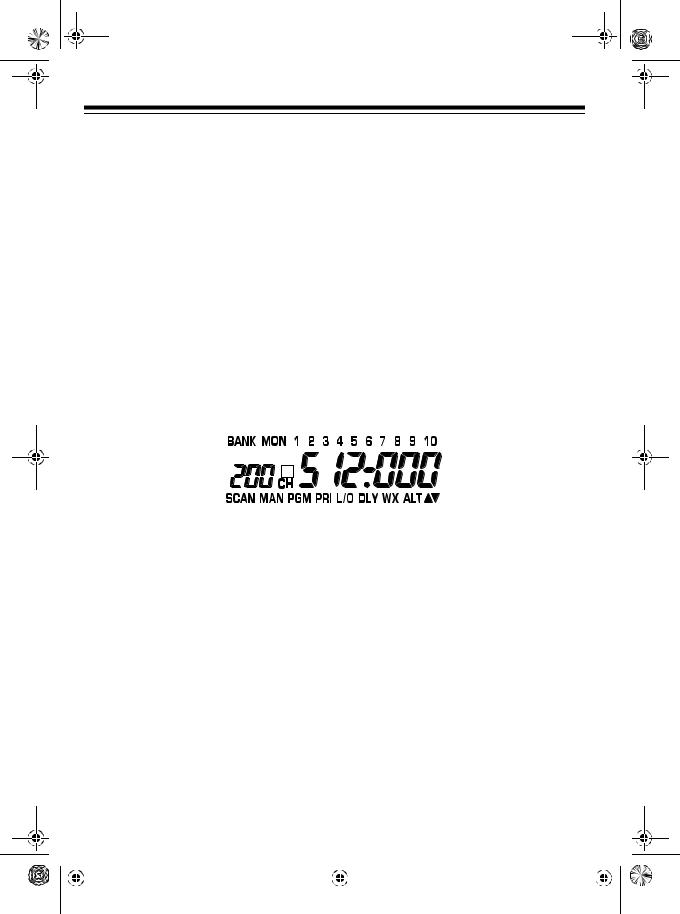
20-422.fm Page 10 Friday, January 7, 2000 12:54 PM
1–9, 0 |
Each key has a single-digit label, and the 1–9 and 0 keys |
|
also have a range of numbers. Use the digits on the keys to |
|
enter the numbers for a channel or a frequency. Use the |
|
range of numbers above the key (61–80 , for example) to se- |
|
lect or deselect the channels in a channel-storage bank. |
CLEAR/. |
Clears an incorrect entry, or enters the decimal point when |
|
you enter a frequency. |
WX/E |
Scans the seven preprogrammed weather channels; stores |
|
frequencies into channels. |
A LOOK AT THE DISPLAY
The display has indicators that show the scanner’s current operating mode. A good look at the display will help you understand your scanner.
|
|
|
|
|
|
|
|
|
|
|
|
|
|
|
|
|
|
|
|
|
|
|
|
|
|
|
|
|
|
|
|
|
|
|
|
|
|
|
|
|
|
|
|
BANK |
Appears with a number (1–10) to its right to show which |
||||||||||
|
|
|
|
|
channel-storage banks are turned on for scanning. |
||||||||
|
|
MON |
Appears with a number (1–10) to its right to show which |
||||||||||
|
|
|
|
|
monitor memory you are listening to. |
||||||||
|
|
|
|
Appears when you tune to a priority channel. |
|||||||||
|
|
P |
|
|
|||||||||
|
|
CH |
Appears with a number (1–200) to its left to show which |
||||||||||
|
|
|
|
|
channel the scanner is tuned to. |
||||||||
|
|
SCAN |
Appears when you scan channels. |
||||||||||
|
|
MAN |
Appears when you manually select a channel. |
||||||||||
|
|
PGM |
Appears when you program the scanner. |
||||||||||
|
|
10 |
|
|
|
|
|
|
|
|
|
|
|
|
|
|
|
|
|
|
|
|
|
|
|
|
|
|
|
|
|
|
|
|
|
|
|
|
|
|
|
|
|
|
|
|
|
|
|
|
|
|
|
|
|
